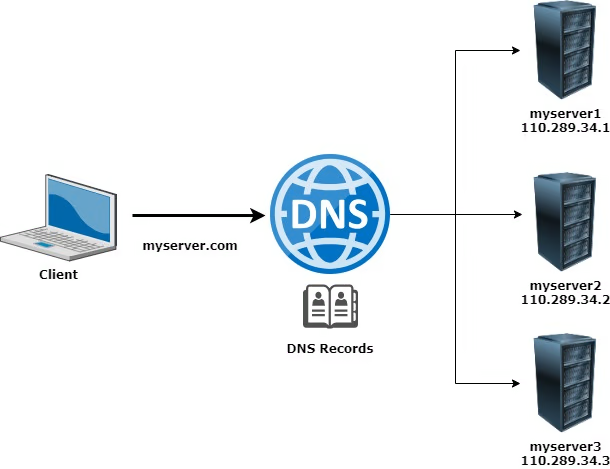Table of Contents
ToggleIntroduction
In today’s digital age, where websites are the backbone of online presence, ensuring optimal performance and availability is crucial. One of the key technologies that help achieve this is DNS load balancing. But what exactly is DNS load balancing, and why is it so important for modern websites? Let’s dive in.
Understanding DNS Basics
What is DNS?
DNS, or the Domain Name System, is commonly described as the internet’s address book It converts user-friendly domain names, such as www.example.com, into IP addresses that computers use to interact with each other.
How DNS Works
When you type a website’s name into your browser, the DNS server retrieves the corresponding IP address and directs your request to the appropriate server. This process ensures that you can access the website without needing to remember complex numerical IP addresses.

Role of DNS in Web Traffic Management
In addition to basic translation, DNS is crucial in managing web traffic. It helps distribute requests across various servers, ensuring that no single server becomes overwhelmed. This is where DNS load balancing comes into play.
What is DNS Load Balancing?
Definition and Purpose
DNS load-balancing is a technique used to spread incoming web traffic across multiple servers. Doing so ensures that no single server bears the entire load, enhancing performance, reliability, and availability.
How DNS Load Balancing Works
When a user requests access to a website, the DNS load balancer directs the request to one of several available servers. The choice of server can be based on various factors, such as server availability, location, or current load, ensuring efficient traffic management.

Types of DNS Load Balancing
Round Robin DNS
One of the simplest forms, Round Robin DNS load balancing, distributes requests sequentially across servers. If there are three servers, the first request goes to Server 1, the second to Server 2, and so on.
Weighted Round Robin DNS
This approach allocates varying weights to servers according to their capacity. A server with a higher capacity may receive more requests than one with a lower capacity.
GeoDNS
GeoDNS or Global DNS directs users to the server closest to their geographical location. This reduces latency and improves load times, particularly for global websites.
Latency-Based DNS
Latency-based DNS selects servers based on the lowest latency, ensuring that users connect to the fastest server available.
Failover DNS
Failover DNS reroutes traffic from a malfunctioning server to a functioning one, guaranteeing high availability and reduced downtime. It enables DNS Load Balancing Failover
Why DNS Load Balancing is Essential
Enhancing Website Performance
By distributing traffic across multiple servers, DNS load-balancing prevents any single server from becoming a bottleneck, ensuring that your website runs smoothly even during peak times.
Ensuring High Availability
DNS load-balancing automatically redirects traffic to another server if one server fails. This redundancy minimizes downtime and keeps your website accessible to users.
Improving User Experience
Faster load times and minimal downtime translate to a better user experience. DNS load-balancing helps achieve this by ensuring that users are always connected to the best available server.
Supporting Global Traffic
For websites with a global audience, DNS load-balancing is crucial. It ensures that users around the world experience consistent performance, regardless of their location.
Benefits of DNS Load Balancing
Scalability
DNS load-balancing allows your website to scale seamlessly. As traffic grows, you can add more servers to the pool without disrupting service.
Redundancy
With multiple servers handling requests, DNS load-balancing provides redundancy, ensuring that even if one server fails, others can pick up the slack.
Cost Efficiency
By optimizing server usage, DNS load-balancing can reduce the need for expensive, high-capacity servers. You can achieve high performance with a distributed network of more affordable servers.
Flexibility
DNS load balancing offers the flexibility to customize traffic distribution based on your specific needs, whether it’s by geography, load, or other factors.
How to configure DNS load balancing
Choosing the Right DNS Provider
Selecting a reliable DNS provider is the first step. Look for providers that offer robust load-balancing features, global coverage, and 24/7 support.
Setting Up DNS Records
Once you have a provider, you’ll need to set up DNS records that define how traffic should be distributed across your servers.
Configuring Load Balancing Rules
Depending on your traffic and server setup, configure rules that determine how traffic is balanced. This could be based on round-robin, server capacity, or geographical location.
Monitoring and Maintenance
Regular monitoring is crucial to ensure that your DNS load balancing setup continues to perform optimally. Be ready to adapt as traffic patterns shift.
Common Challenges in DNS Load Balancing
DNS Propagation Delays
Updating DNS records can take a while to spread across the internet, causing temporary discrepancies in how traffic is distributed.
Misconfigurations
Incorrectly setting up DNS records or load balancing rules can lead to traffic being unevenly distributed, negating the benefits of load balancing.
Security Concerns
DNS load balancers can be targets for attacks, such as DDoS. It’s essential to implement security measures to protect your DNS infrastructure.
Handling Traffic Spikes
Unexpected traffic spikes can still overwhelm a server setup that is otherwise well-balanced. Having a strategy ready to manage such situations is crucial.
Best Practices for Effective DNS Load Balancing
Regular Monitoring and Updates
Keep an eye on your DNS load balancing setup and update it regularly to adapt to changing traffic patterns.
Combining DNS Load Balancing with Other Techniques
For optimal performance, consider combining DNS load balancing with other load balancing techniques, such as application-level load balancing.
Prioritizing Security
Implement robust security measures to protect your DNS infrastructure from attacks.
Testing Failover Mechanisms
Regularly test your failover setup to ensure that it works as expected in case of server failure.
DNS Load Balancing Tools and Services
Overview of Popular DNS Load Balancing Tools
Several tools offer DNS load-balancing features, including Amazon Route 53, Cloudflare, and Akamai.
Comparison of DNS Load Balancing Services
Compare the features, pricing, and performance of different DNS load-balancing services to find the best fit for your needs.
Selecting the Best Tool for Your Needs
Consider your website’s traffic, geographic distribution, and budget when selecting a DNS load-balancing tool.
Case Studies: Successful DNS Load Balancing
Real-World Examples
Real-World Example of DNS Load Balancing
Consider a popular e-commerce website during a major sale event. To handle the surge in traffic, the site employs DNS load-balancing. As users from around the globe access the site, DNS load-balancing distributes their requests across multiple servers located in different regions. This not only ensures that no single server is overloaded but also improves loading times for users by directing them to the nearest server. If one server experiences a problem, DNS load-balancing seamlessly redirects traffic to the remaining operational servers, keeping the website accessible and responsive despite the high volume of traffic.
A major online streaming service uses DNS load balancing to manage its global user base. During peak hours, such as when a popular new episode is released, millions of users simultaneously access the service. DNS load-balancing helps by directing users to different servers based on their geographical location. For instance, users in North America might be routed to servers in the U.S., while users in Europe are directed to servers in Germany or the UK. This distribution prevents any single server from becoming overwhelmed and ensures smooth, uninterrupted streaming for all users. If a server experiences issues or high traffic, DNS load-balancing quickly redirects users to the nearest available server, maintaining high performance and availability.
Future of DNS Load Balancing
Emerging Trends
Stay ahead of the curve by keeping an eye on emerging trends in DNS load balancing, such as AI-driven traffic management.
Impact of New Technologies
Understand how new technologies, like 5G and edge computing, will impact DNS load balancing in the coming years.
Predictions for the Future
Get insights into where DNS load balancing is headed and how it will continue to evolve to meet the needs of modern websites.
Conclusion
DNS load balancing is a critical component of modern website management. It ensures that your website remains fast, reliable, and available to users around the globe. By understanding the basics, implementing best practices, and staying informed about future trends, you can leverage DNS load-balancing to deliver an exceptional user experience.
FAQs
What is the difference between DNS load balancing and traditional load balancing?
DNS load balancing distributes traffic across servers at the DNS level, while traditional load balancing typically operates at the application level. DNS load-balancing is often used for distributing traffic across geographically dispersed servers.
How does DNS load balancing affect SEO?
Properly configured load balancing can improve website speed and availability, both of which are factors that can positively impact SEO rankings.
Can DNS load balancing handle DDoS attacks?
While load balancing can help distribute traffic and mitigate the impact of DDoS attacks, it’s not a complete solution. Additional security measures, such as firewalls and DDoS protection services, are recommended.
Is DNS load balancing suitable for small websites?
Yes, even small websites can benefit from load balancing, particularly if they experience traffic spikes or need to ensure high availability.
How do I choose the right DNS load-balancing strategy?
The right strategy depends on your specific needs, including your website’s traffic patterns, geographic distribution, and budget. When choosing a strategy, Consider server capacity, user location, and redundancy.

